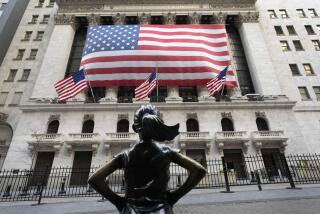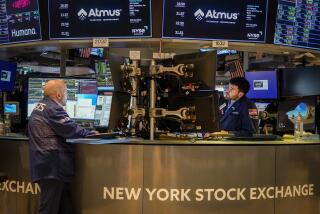Stocks plunge on fears over emerging markets
NEW YORK — Wall Street took a drubbing for the second straight day as investors worry that an economic slowdown in emerging markets could trigger a correction in stocks.
The Dow Jones industrial average suffered a drop of 318.24 points Friday, the worst one-day plummet since June of last year. The blue-chip index has plunged almost 500 points during the two-day rout, and follows big drops in European and Asian markets.
QUIZ: How much do you know about the Dow?
Investors were rattled by a confluence of problems around the world: A dour economic report in China, political unrest in Turkey and financial turmoil in Argentina. But one of the biggest concerns is that the Federal Reserve’s tightening of easy-money policies could hurt emerging market economies.
The Federal Reserve’s stimulus programs benefited risky assets such as stocks, boosting the Dow 27% last year. They also lifted stocks in emerging markets around the globe. But the central bank’s pullback now has investors wondering whether those countries can stand on their own.
Some on Wall Street believe a long-overdue correction could be ahead. Since Jan. 1, the Dow has retreated 4% — still below the 10% that’s considered correction territory. Investors have yanked out $625 billion from stocks this month overall, as measured by the Wilshire 5000 Total Market Index.
“We had way too much complacency at the end of last year,” said Nicholas Colas, chief market strategist at ConvergEx Group in New York. “You layer those things on together and it’s made for an incredibly rocky start of the year.”
On Friday, the Dow tumbled 318.24 points, or nearly 2%, to 15,879.11. The index shed 175.99 points on Thursday.
The broader Standard & Poor’s 500 index fell 38.17 points, or 2.1%, to 1,790.29. The technology-focused Nasdaq composite shed 90.70 points, or 2.2%, to 4,128.17.
Markets overseas also fell, with the Stoxx Europe 600 index declining 2.4% and the Nikkei shedding 2% during the session.
As investors dumped currencies and bonds of emerging market countries, they plowed into traditional safe havens.
Bonds of developed countries rallied. The yield on the benchmark 10-year U.S. Treasury note fell to 2.72% from 2.78% the previous day. The 10-year note is off recent highs of about 3% as investors drive up its price (bond yields fall when prices rise).
“There was a lot of liquidity … that just kept the party going overseas,” said Karyn Cavanaugh, a market strategist at ING U.S. Investment Management. “Now that the word is out that the Fed is tapering — and indeed they are tapering — there are worries that the liquidity is going to dry up and that people are pulling their money back.”
One area the U.S. markets aren’t getting much help from is corporate earnings — at least so far.
Investors have been closely watching fourth-quarter results as a potential catalyst for stocks. Analysts expect 5.9% year-over-year earnings growth for the average company in the S&P 500, according to research firm S&P Capital IQ.
That’s lower than the 9.6% profit growth predicted in October, according to S&P Capital IQ.
“While they’re certainly encouraging, they haven’t been blowing the doors off anybody’s expectations,” said Jack Ablin, chief investment officer at BMO Private Bank.
Still, some professional investors were careful to avoid sounding alarmist with the stock market’s recent drops. Strong bull markets often endure bruising, short-lived retreats, they note.
Either way, the increased volatility is a sign that markets are getting used to a new reality.
“For the last four years we’ve had the world’s central banks providing a lot of liquidity into the financial system, and that has smoothed over a lot of bumps,” Colas said. “Now that markets understand that that era is coming to an end, those bumps are now visible again.”





